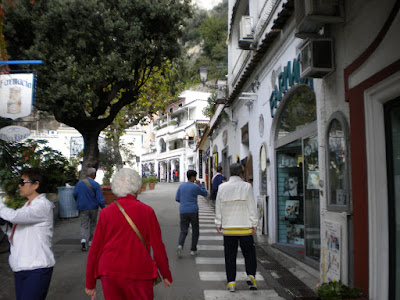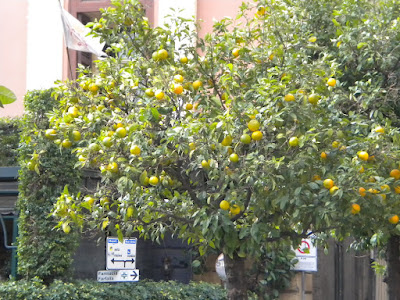Today we are at our last port of the cruise before we arrive back in Barcelona. We, in a group of 6 Cruise Critic friends, met our guide/driver at about 8 a.m. outside of the port area of Naples, Italy, for our tour that included Positano, Sorrento, and Pompeii.
The drive from the port southeast along the Amalfi coast included some absolutely beautiful views.
We stopped for a group photo. Left to right: Sylvia & Jim; Jason & Katy from TN. who are expecting twins in the summer; Pushpa & Has from NJ, mentioned earlier in this blog.
The flowers and the fruit, here on the Amalfi coast are wonderful!
We arrived in Positano…and parked under the hill inside a parking garage in the area of this gas station.
From here, we started our walk through Positano. Positano is a small town on the Amalfi Coast in Campania, Italy. The main part of the city sits in an enclave in the hills leading down to the coast.
Positano was a port of the Amalfi Republic in medieval times, and prospered in the 16th and 17th centuries. But by the mid-19th century, the town had fallen on hard times. More than half the population emigrated, mostly to Australia. Positano was a relatively poor fishing village during the first half of the 20th century. It began to attract large numbers of tourists in the 1950s, especially after John Steinbeck published his essay about Positano in Harper's Bazaar in May, 1953: "Positano bites deep", Steinbeck wrote. "It is a dream place that isn’t quite real when you are there and becomes beckoningly real after you have gone."
Positano has been featured in several films, including Only You (1994), and Under the Tuscan Sun (2003), as well as being mentioned in the 2009 musical film Nine in the song "Cinema Italiano". Positano is also the setting for the love story in the recent American novel, "Finding Positano" (2010) by William James. Mick Jagger and Keith Richards wrote the song “Midnight Rambler” in the cafes of Positano while on vacation.
We departed from this area on foot, walking around this curve…The streets were barely wide enough for 2 small automobiles to pass…
The placement of the homes on the hillsides above the street was so interesting.
The colorful, narrow walkways…
With the sea as a backdrop…
In about 1 1/2 hours we returned to our starting point and proceeded to board the van for the trip to Sorrento following along the “Amalfi Drive”.
The Amalfi Drive (connecting Sorrento and Amalfi) is a narrow road that threads along the high cliffs above the Tyrrhenian Sea. Sorrento's sea cliffs and luxury hotels have attracted notable people, including Enrico Caruso and Luciano Pavarotti.
We see these lovely homes clustered along the hillsides as we travel…
And the sea….
And, about 11:30 a.m. we arrived in Sorrento a small town in Campania, southern Italy, with some 16,500 inhabitants. The town overlooks the Bay of Naples as the key place of the Sorrentine Peninsula, and many viewpoints allow sight of Naples itself, Vesuvius and the Isle of Capri.
Sorrento is famous for the production of limoncello, a liqueur made from lemon rinds, alcohol, water and sugar. A number of people who were on our ship enjoyed limoncello so much that they attempted to bring home a bottle in their luggage. Some made it home; others were confiscated in various airports.
The ancient Roman city of Surrentum which stood on this site (presently, Sorrento) was described as “very secure, protected by deep gorges”. Today, from the everyday streets of the city one can look down and see one of the gorges with the lush, beautiful greenery.
Above, there’s also lovely greenery…
Here is one of the downtown streets of Sorrento. It was a Sunday morning when we visited here. From all appearances, it seemed that the local custom was for the whole family to get dressed in their best clothes, walk to a local church (Catholic, of course; this is Italy) and then after mass, walk to a restaurant for lunch followed by a stroll of the streets.
Here, a family with a stroller for 3 (and 3 little ones in it) caught my attention.
And, so did this lovely home behind the gate.

This street, surrounded with lovely plantings, led off to a restricted area.
This nice park in the middle of a roundabout.
And these are some of the lemons used might be used to make the lemoncello.
The lemon trees seem to be growing everywhere.
We stopped for lunch in an Italian restaurant where some of us had “authentic” pizza. (I think we prefer an Americanized version).
After lunch we met our driver and boarded the van for Pompeii, Italy. A portion of the drive was along the route we had traveled earlier in the day. Then we turned northeastward away from the coast toward the more central part of Campania region.
Pompeii is in the Italian region of Campania, near Naples. Pompeii is close to the Bay of Naples. The Romans took control of Pompeii around 200 BC. On August 24, 79 A.D., the volcano Vesuvius erupted and buried the nearby town of Pompeii in ash and soot, killing 20,000 people, and preserving the city in its state from that fateful day. Pompeii is an excavation site and outdoor museum of the ancient Roman settlement. This site is considered to be one of the few sites where an ancient city has been preserved in detail-- everything from jars and tables to paintings and people were frozen in time, yielding an unprecedented opportunity to see how the people lived two thousand years ago.
This appears to be the frame of a dog now incased in glass.
And a human inside this glass case.
Another human…
A third…
We departed the site of the ruins of Pompeii and walked through this beautiful, peaceful garden.
The ride back to the Brilliance of the Seas seemed long even though it really wasn’t. We arrived in the dark and the rain.










































































No comments:
Post a Comment